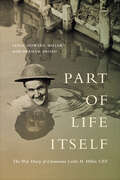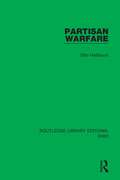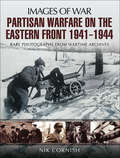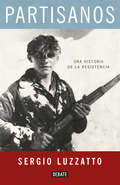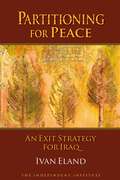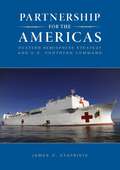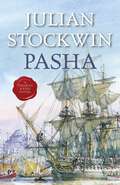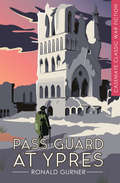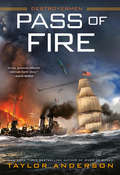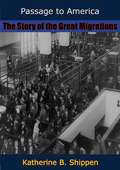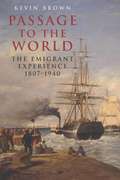- Table View
- List View
Part of Life Itself: The War Diary of Lieutenant Leslie Howard Miller, CEF (The Canadian Experience of War)
by Leslie MillerThis extensively annotated wartime diary illuminates the military service of Leslie Howard Miller (1889–1979), a Canadian soldier who served in the First World War. Miller joined the Canadian Expeditionary Force (CEF) in 1914. In his off-duty hours, he kept this extraordinarily eloquent diary of his training, deployment overseas, service on the Western Front, and periods of leave in the United Kingdom. Graham Broad, working from a transcription of the diary produced by Miller’s family, includes a thorough introduction and afterword, as well as over 500 notes that situate and explain Miller’s many references to the people, places, and events he encountered. Unpublished for over a century, written in bracing and engaging prose, and illustrated with Miller’s own drawings and unseen photographs, Part of Life Itself illuminates a bygone world and stands as one of Canada’s most important wartime diaries.
Partisan Warfare
by Colonel The Hon. C. M. Woodhouse Dr Otto HeilbrunnDr Heilbrunn has already established himself as a historian of irregular warfare. But the subject is not merely a matter of past history, because the so-called 'nuclear stalemate', which has made total warfare improbable, has at the same time made limited warfare the only kind that the world can afford to risk. One hopes, naturally, that the risk will be avoided; but since even a conventional war of the traditional, pre-nuclear kind might easily lead unintentionally up to a total war between great powers and is therefore also likely to be avoided, there remains the residual danger of what may be called 'sub-conventional' warfare in marginal areas, which the great powers would be free to support or disown, to fan up or suppress, according to their immediate interpretation of their own interests. Such are the outbreaks which we have seen in recent years in Malaya, Vietnam, Algeria, Cyprus, Cuba, Laos and elsewhere. These are also, if Korea proves, as we hope, to have been the last conventional war between major powers, the kinds of war we must expect to see renewed in the future.The Resistance during the Second World War was the prelude to this new kind of warfare. It was not, of course, a new invention between 1940 and 1945: one remembers, on the contrary, the Spanish resistance during the Napoleonic Wars, which gave us the word guerrilla to add to our language, and the exploits of Lawrence and others during the Arab Revolt of 1917. But these were side-shows (Lawrence's own word) in support of a major conventional war, without which they would have achieved practically nothing. Since the Second World War, the corresponding outbreaks of irregular warfare have stood on their own as the major, if not the only, armed conflicts in their particular struggle, not a side-show in support of a major war elsewhere. The Spanish Civil War of 1936-8 is their archetype. Irregular warfare has accordingly become more professional and highly organized. It has had to acquire a sense of strategy, not merely of tactics. Perhaps eventually it will drop the epithet 'irregular'. Even by 1945 the 'partisans' of southern Europe and the Balkans had ceased to so describe themselves, and adopted instead the nomenclature of regular armies.Those who fought with the partisans of the Second World War will find that already there have been profound changes in the evolution of partisan warfare since 1945. But thanks to Dr Heilbrunn's keen sense of the continuity of that evolution, they will also recognize their own side-shows as forming an integral part of the history of this fascinating subject. He does us the honour of frequent quotation from our accounts of war-time experience; and it is encouraging to find that the lessons of that experience have been confirmed by later application elsewhere. His book is perhaps the first comprehensive study of the theoretical aspects of partisan warfare, at least in the English language. It is firmly grounded in practice, and likely to serve for a long time as a standard work.
Partisan Warfare (Routledge Library Editions: WW2 #23)
by Otto HeilbrunnThis book, first published in 1962, was the first systematic study of partisan war, investigating questions thrown up by the success of guerrillas in the Second World War, where they were never decisively beaten by regular armies. Drawing on lessons from Soviet Russia and China in particular, areas with especially active and large partisan forces, this book evolves a doctrine of guerrilla war in modern conditions, with an analysis of partisans in post-war Malaya, Kenya, Cyprus, Vietnam, Algeria, Cuba and Laos.
Partisan Warfare on the Eastern Front, 1941–1944 (Images of War)
by Nik CornishBetween 1941 and 1944, in the war on the Eastern Front, Soviet partisans fought a ruthless underground campaign behind the German lines. During those three terrible years of occupation they spied on the Germans, disrupted their communications, sabotaged road and rail routes and carried out assassinations and raids, and thousands of these irregular soldiers lost their lives. Yet their exploits are frequently overlooked in general histories of the conflict, and their experience of the war and their contribution to the Soviet victory are rarely recognized. That is why Nik Cornishs collection of photographs of the Soviet partisans is a landmark in the field. In a sequence of over 150 images, most of them previously unpublished, he gives a fascinating all-round portrait of the lives of the partisans and their struggle to resist and survive in a war that was waged with almost unparalleled cruelty on both sides. And, in his commentary, he outlines the history of the partisans - their desperate, chaotic beginnings in the wake of the German attack, their increasing coordination, daring and effectiveness as the war went on, and the key role they played as the Germans were forced back. He also records, through the photographs, the merciless counter-measures taken by the Germans and the reprisals. His book gives a compelling insight into one of the most important side shows of the Second World War.
Partisanos
by Sergio Luzzatto"Partisanos" se llamaba en dialecto piamontés a los combatientes de la Resistencia, hábiles en el uso de las armas, decididos y resueltos; y así tituló Primo Levi un poema en 1981.Levi; formidable escritor, combatió como partisano en el valle de Aosta en otoño de 1943, pero corrió un tupido velo sobre esas semanas antes de su captura y deportación a Auschwitz, apenas mencionó un «secreto desagradable». Tras investigar este secreto y ampliar la mirada desde el valle de Aosta hasta el noroeste de Italia, Sergio Luzzatto cuenta -a través de una historia de la Resistencia- la historia de la Resistencia y los dilemas morales que acuciaron a los jóvenes de una nación a la desbandada tras la rendición de Italia a los aliados y la creación de la República de Saló. En este libro, que provocó un encendido debate, Luzzatto restituye figuras vivas, y no santos de la Resistencia ni monstruos de Saló. Y entre estas figuras, está la de Primo Levi: dolido, y antes que testigo de la Solución final delproblema judío, testigo de los aspectos más escabrosos de una guerra civil. "Partisanos" es un extraordinario ensayo histórico que ilumina magistralmente el problema fundamental de la legitimidad y la moralidad de la violencia.
Partisans
by Alistair MacLeanMajor Peter Petersen leads a commando force to the Balkans during WWII, to deliver a mysterious message to the Partisans, the Yugoslavian Royalists, from the Fascists. Petersen knew it couldn't be a smooth operation. That sixth sense a veteran acquires warned him -- of a setup. His order reek of doublecross and deception. But he has his own reasons for playing along with the Facists... and delivering them their due!
Partisans of the Kuban
by J. Fineberg P. K. IgnatovThe brutal repressive measures of the German Wehrmacht during the Second World War led to uprisings and partisan actions all over the vast captured territories that were occupied during their triumphal years of 1940 and 1941. Few regions caused as much trouble for the occupying forces than the provinces of Russia, many of whom broke into almost open revolt. This book chronicles the operations of the Ignatov brother's partisan unit which did a great deal of damage to the German war effort in the Kuban. The account is based on a diary that the unit kept during their struggle against the invaders.
Partition: The story of Indian independence and the creation of Pakistan in 1947
by Barney White-SpunnerBetween January and August 1947 the conflicting political, religious and social tensions in India culminated in independence from Britain and the creation of Pakistan. Those months saw the end of ninety years of the British Raj, and the effective power of the Maharajahs, as the Congress Party established itself commanding a democratic government in Delhi. They also witnessed the rushed creation of Pakistan as a country in two halves whose capitals were two thousand kilometers apart. From September to December 1947 the euphoria surrounding the realization of the dream of independence dissipated into shame and incrimination; nearly 1 million people died and countless more lost their homes and their livelihoods as partition was realized. The events of those months would dictate the history of South Asia for the next seventy years, leading to three wars, countless acts of terrorism, polarization around the Cold War powers and to two nations with millions living in poverty spending disproportionate amounts on their military. The roots of much of the violence in the region today, and worldwide, are in the decisions taken that year. Not only were those decisions controversial but the people who made them were themselves to become some of the most enduring characters of the twentieth century. Gandhi and Nehru enjoyed almost saint like status in India, and still do, whilst Jinnah is lionized in Pakistan. The British cast, from Churchill to Attlee and Mountbatten, find their contribution praised and damned in equal measure. Yet it is not only the national players whose stories fascinate. Many of those ordinary people who witnessed the events of that year are still alive. Although most were, predictably, only children, there are still some in their late eighties and nineties who have a clear recollection of the excitement and the horror. Illustrating the story of 1947 with their experiences and what independence and partition meant to the farmers of the Punjab, those living in Lahore and Calcutta, or what it felt like to be a soldier in a divided and largely passive army, makes the story real. Partition will bring to life this terrible era for the Indian Sub Continent.
Partitioning for Peace: An Exit Strategy for Iraq
by Ivan ElandCombining a history of Iraq and its dominant sects with an acute awareness of the political machinations fomenting worldwide, this keen military analysis offers a practical exit strategy for U.S. armed forces in Iraq.Since the history of violence in multi-ethno-sectarian states indicates that such conflicts usually resurface once an occupying force leaves, a solution to end the violence and stabilize the country must be geographically reasonable for sectarian groupings. Ivan Eland explains why partitioning, a solution that has been successful in other chaotic political situations, can be a uniquely effective political and military exit strategy for a country like Iraq. Finally, Dr. Eland documents fifteen lessons that can be learned from previous partitions during the 20th and 21st centuries and applies them directly to the current situation in Iraq.
Partners in Command
by Mark PerryA unique look at the complex relationship between two of America?s foremost World War II leaders The first book ever to explore the relationship between George Marshall and Dwight Eisenhower, Partners in Command eloquently tackles a subject that has eluded historians for years. As Mark Perry charts the crucial impact of this duo on victory in World War II and later as they lay the foundation for triumph in the Cold War, he shows us an unlikely, complex collaboration at the heart of decades of successful American foreign policy?and shatters many of the myths that have evolved about these two great men and the issues that tested their alliance. As exciting to read as it is vitally informative, this work is a signal accomplishment. .
Partners in Command: The Relationships Between Leaders in the Civil War
by Joseph GlatthaarExplores the productive friendships of such contrasting personalities as Grant and Sherman and Robert E. Lee and Stonewall Jackson, bringing to life the struggle between McClellan and Lincoln and Jefferson Davis and Joseph E. Johnston.
Partnership for the Americas: Western Hemisphere Strategy and U.S. Southern Command
by James G. StavridisSince its creation in 1963, United States Southern Command has been led by 30 senior officers representing all four of the armed forces. None has undertaken his leadership responsibilities with the cultural sensitivity and creativity demonstrated by Admiral Jim Stavridis during his tenure in command. Breaking with tradition, Admiral Stavridis discarded the customary military model as he organized the Southern Command Headquarters. In its place he created an organization designed not to subdue adversaries, but instead to build durable and enduring partnerships with friends. His observation that it is the business of Southern Command to launch "ideas not missiles" into the command's area of responsibility gained strategic resonance throughout the Caribbean and Central and South America, and at the highest levels in Washington, D.C..-Print Edition.
Partnership: George Marshall, Henry Stimson, and the Extraordinary Collaboration That Won World War II
by Edward Farley AldrichOn September 1, 1939, the day World War II broke out in Europe, Gen. George Marshall was sworn in as chief of staff of the U.S. Army. Ten months later, Roosevelt appointed Henry Stimson secretary of war. For the next five years, from adjoining offices in the Pentagon, Marshall and Stimson headed the army machine that ground down the Axis. Theirs was one of the most consequential collaborations of the twentieth century. A dual biography of these two remarkable Americans, The Partnership tells the story of how they worked together to win World War II and reshape not only the United States, but the world.The general and the secretary traveled very different paths to power. Educated at Yale, where he was Skull and Bones, and at Harvard Law, Henry Stimson joined the Wall Street law firm of Elihu Root, future secretary of war and state himself, and married the descendant of a Founding Father. He went on to serve as secretary of war under Taft, governor-general of the Philippines, and secretary of state under Hoover. An internationalist Republican with a track record, Stimson ticked the boxes for FDR, who was in the middle of a reelection campaign at the time. Thirteen years younger, George Marshall graduated in the middle of his class from the Virginia Military Institute (not West Point), then began the standard, and very slow, climb up the army ranks. During World War I he performed brilliant staff work for General Pershing. After a string of postings, Marshall ended up in Washington in the 1930s and impressed FDR with his honesty, securing his appointment as chief of staff.Marshall and Stimson were two very different men who combined with a dazzling synergy to lead the American military effort in World War II, in roles that blended politics, diplomacy, and bureaucracy in addition to warfighting. They transformed an outdated, poorly equipped army into a modern fighting force of millions of men capable of fighting around the globe. They, and Marshall in particular, identified the soldiers, from Patton and Eisenhower to Bradley and McNair, best suited for high command. They helped develop worldwide strategy and logistics for battles like D-Day and the Bulge. They collaborated with Allies like Winston Churchill. They worked well with their cagey commander-in-chief. They planned for the postwar world. They made decisions, from the atomic bombs to the division of Europe, that would echo for decades. There were mistakes and disagreements, but the partnership of Marshall and Stimson was, all in all, a bravura performance, a master class in leadership and teamwork.In the tradition of group biographies like the classic The Wise Men, The Partnership shines a spotlight on two giants, telling the fascinating stories of each man, the dramatic story of their collaboration, and the epic story of the United States in World War II.
Party Shoes
by Noel StreatfeildSet during and after the second World War, this classic novel tells the story of Selina, who has been sent to live with her aunt, uncle, and cousins in the country. When Selina receives a parcel from her godmother in America it causes much excitement among her and her cousins, and, to Selina's delight, the parcel contains a beautiful party dress and a pair of party shoes. But delight turns to dismay when she realizes that she may never have an occasion to wear such a wonderful outfit - until, that is, she and her cousins come up with an idea of organizing a pageant...
Party in the Street
by Fabio Rojas Michael T. HeaneyParty in the Street explores the interaction between political parties and social movements in the United States. Examining the collapse of the post-9/11 antiwar movement against the wars in Iraq and Afghanistan, this book focuses on activism and protest in the United States. It argues that the electoral success of the Democratic Party and President Barack Obama, as well as antipathy toward President George W. Bush, played a greater role in this collapse than did changes in foreign policy. It shows that how people identify with social movements and political parties matters a great deal, and it considers the Tea Party and Occupy Wall Street as comparison cases.
Pascal's Wager: The Man Who Played Dice with God
by James A. ConnorIn a major biography of Blaise Pascal, James Connor explores both the intellectual giant whose theory of probability paved the way for modernity and the devout religious mystic who dared apply probability to faith.
Pasha
by Julian StockwinIn the 15th volume in the popular high-seas nautical adventure series featuring naval hero Thomas Kydd, an Admiralty summons to England cuts short Kydd's service in the Caribbean. While the crew of L'Aurore look forward to liberty and prize money, a shadow hangs over her captain: the impending court martial of Kydd's one-time commander, Commodore Popham, who led a doomed attack on South America.Following Nelson's death two years earlier, England is in desperate need of heroes and Kydd's Caribbean exploits are the talk of London. Feted by the king and a grateful country, Kydd is soon on detachment in the dangerous Dardanelles connecting the Mediterranean Sea to the Black Sea and providing a route to India. The French have long coveted this route, knowing that it could be the key to toppling the British Empire in India. When they successfully whip up such strong anti-English sentiment that the British ambassador to Constantinople has to flee to L'Aurore, a deadly stand-off ensues. Meanwhile Kydd's closest friend, Nicholas Renzi, has assumed a new role that he can never make public. Sent under alias on a mission to Constantinople, Renzi must engineer a coup that will turn the tables on the French. But when he's taken prisoner, only Kydd's superb seamanship and sheer bravado can save the day.
Pashtun: A Military Thriller
by Ron LealosAn adrenaline-filled war story that depicts the challenges of military special operations in a dangerous, boulder-filled landscapeThe Company has a special secret operation planned for one of their top agents: the leaders of the Taliban and al-Qaeda terrorist groups are hiding out in Pashtun country, and they must be eliminated. The job falls to a man they have named Frank Morgan-an agent who stood out as a recruit at Quantico and whose skills resemble those of the legendary Vietnam assassin. The other soldiers claim Frank’s abilities as a sniper and a tracker border on the supernatural and are more than willing to complete this mission with him.Frank begins his adventure in Afghanistan with another Company-appointed soldier: an indestructible lyrical Irishman with a cutting sense of humor and a bottle of Jameson never far from hand. After the men rescue a burqa-clad young woman, they soon discover that the Company has not been honest with them and decide to take a second mate under their wing-a giant who quotes poetry and rap songs while he both enacts torture and lives through his own agonizing trials.They know now that oil, drugs, and greed have led to this quest; assassinating the terrorists is not their main objective. However, this still must be done. After becoming dangerously acquainted with the heroin business in the frontier provinces, Frank and his comrades continue their mission. But the lines have now blurred, and the assignment is more complicated than they expected.Skyhorse Publishing, as well as our Arcade, Yucca, and Good Books imprints, are proud to publish a broad range of books for readers interested in fiction-novels, novellas, political and medical thrillers, comedy, satire, historical fiction, romance, erotic and love stories, mystery, classic literature, folklore and mythology, literary classics including Shakespeare, Dumas, Wilde, Cather, and much more. While not every title we publish becomes a New York Times bestseller or a national bestseller, we are committed to books on subjects that are sometimes overlooked and to authors whose work might not otherwise find a home.
Pass Guard at Ypres: A Novel (Casemate Classic War Fiction #5)
by Ronald GurnerFrom a World War I veteran: A novel of the years-long, brutal battle at Ypres, Belgium, and what it did to the city and the men who fought there. In 1915, a platoon of inexperienced British soldiers arrives in Flanders, excited and anxious for what is to come. But they soon find themselves at Ypres, where the battle-weary Allied troops have dug in and slaughter surrounds them. Soldiers, from privates to senior officers of the wider battalion, frozen by terror and overwhelmed by the relentless stress as the battle drags on, want nothing more than to hide. Young, dedicated officer Freddy Mann is in the thick of it with his men—burying the dead, experiencing the terror of bombardment, and being picked off by snipers. On a journey from idealistic officer barely out of school to battle-hardened cynic barely hanging on as those around him are cut down, Mann suffers a crisis of faith as he loses his belief in the war and everything he once stood for. Written by a WWI veteran, Pass Guard at Ypres brings to life the harrowing realities of the Great War, portraying years of lengthy fighting in—and the pivotal strategic role of—the ancient and once-peaceful town on the bank of the Ieperlee River.
Pass of Fire (Destroyermen #14)
by Taylor AndersonAfter being transported to a strange alternate Earth, Matt Reddy and the crew of the USS Walker have learned desperate times call for desperate measures, in the return to the New York Times bestselling Destroyermen series.Time is running out for the Grand Human and Lemurian Alliance. The longer they take to prepare for their confrontations with the reptilian Grik, the Holy Dominion, and the League of Tripoli, the stronger their enemies become. Ready or not, they have to move--or the price in blood will break them. Matt Reddy and his battered old destroyer USS Walker lead the greatest army the humans and their Lemurian allies have ever assembled up the Zambezi toward the ancient Grik capital city. Standing against them is the largest, most dangerous force of Grik yet gathered. On the far side of the world, General Shinya and his Army of the Sisters are finally prepared for their long-expected assault on the mysterious El Paso del Fuego. Not only is the dreaded Dominion ready and waiting for them; they've formed closer, more sinister ties with the fascist League of Tripoli. Everything is on the line in both complex, grueling campaigns, and the Grand Alliance is stretched to its breaking point. Victory is the only option, whatever the cost, because there can be no second chances.
Passage to America: The Story of the Great Migrations
by Katherine B. ShippenOriginally published in 1950, this is a comprehensive account of the peaks and troughs of migrations to America, beginning with its original formation of the nation through to the influx of Displaced Persons.Relating the American migrations to great movements in world history on the one hand, and to the national ideal of freedom on the other, the author discusses national and cultural migrations specifically—the French, Dutch, Norwegians, Swedes, Germans, Irish, Chinese, Italians, Russians, Russian Jews, and the refugees and survivors of World War II.“Stimulating reading for all young Americans, at home or in the classroom.”—Kirkus Review“Passage to America was not written as propaganda, yet its very nature makes it a weapon fitted to any hand that is raised in the fight for freedom….It is good in these days to find a book that in strong but not bitter style denounces tyranny and, without any frantic flag-waving, upholds the democratic way of Life.”—Sunday Review of Literature“A living story of the meaning of democracy. The narrative moves easily and smoothly, and the book should arouse the interest of anyone over twelve or thirteen who looks at it.”—The Horn Book
Passage to Freedom
by Ken Mochizuki Hiroki SugiharaHere is the authorized true story of Chiune Sugihara, the "Japanese Schindler", who saved thousands of Jews during World War II. "Passage to Freedom" tells Sugihara's heroic story, highlighting his courageous humanity and the importance of a child's opinion in his father's decision. "American Bookseller" Pick of the Lists. Full-color illus.
Passage to Mutiny (Richard Bolitho Ser. #7)
by Alexander KentIn 1789 Captain Richard Bolitho is aboard the frigate Tempest in the South Pacific, where he is to protect English shipping lanes from seagoing enemies. At the same time he must contain a growing mutiny aboard his own ship. Sequel to Command a King's Ship, 1976.
Passage to Petrograd (Common Smith VC Adventures)
by Charles WhitingCommon Smith's most dangerous mission yet...Russia, 1924. Lenin, Communist Dictator of Russia, is dying. In the wings, his chief aides are jostling for power, and in the provinces revolution is brewing once more. Soviet Russia is on the brink of explosion...Caught up in the turmoil is Serge, the illegitimate teenage son of Tsar Nicholas II, who was executed by the Communists in 1918. Determined to save this member of his extended family, King George V of Britain orders his rescue."C", the elusive head of the British Secret Service, can think of only one man for the task: Common Smith VC and the crew of Swordfish. Their orders, to smuggle Serge out of Petrograd and return to Britain.But Serge hasn't only attracted the attention of the British. The only surviving descendent of Nicholas II, he could be a rallying point for Russians who want to reinstate the Tsar. And there are forces who will stop at nothing to ensure that doesn't happen...A high-stakes, tension-filled adventure perfect for fans of Alex Gerlis and Max Hennessy.
Passage to the World: The Emigrant Experience, 1807–1940
by Kevin BrownFrom the early nineteenth century onwards, literally millions of people left their homes to cross the seas. Some, like the convicts transported to Australia, had no choice; others like the indentured Indian and Chinese labourers had almost no alternative; but the vast majority were driven to escape war, famine or grinding poverty in Europe by seeking a new life abroad. Whatever their circumstances and wherever their destination, the one experience they all shared in common was the sea voyage.This book is centred on the rite of passage that marked the transition from one life to the other, tracing the story of the emigrant, through a fresh look at original sources and first-hand accounts, from the decision to emigrate, the journey to the port and the voyage itself, to arrival in the new world. It describes the emigrant trade, the differing conditions on board sailing ships and steamers, convict and coolie ships, and the perils of overcrowding, epidemics, fire, shipwreck and even cannibalism. It also investigates the varied receptions emigrants were likely to face not necessarily the welcome promised the homeless, tempest-tost by the Statue of Liberty.This unprecedented population shift left few European families untouched by emigration, while the present-day populations of the Americas and Australasia are dominated by the descendants of those who made the journey. This gives the emigrants story a universal interest.
